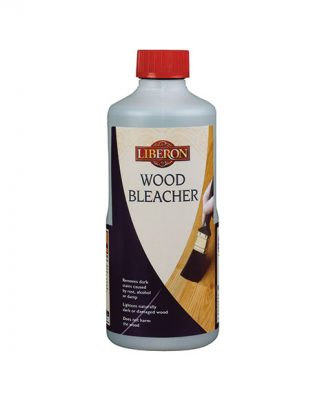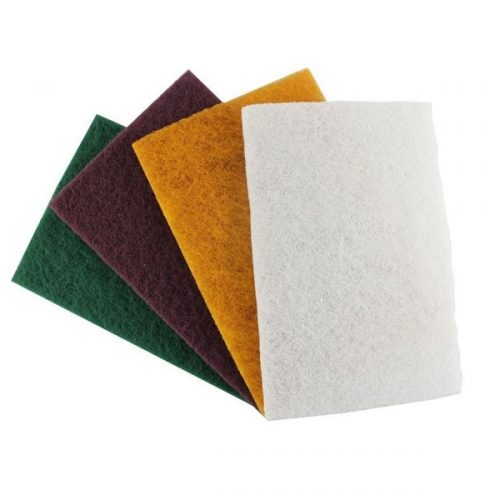-
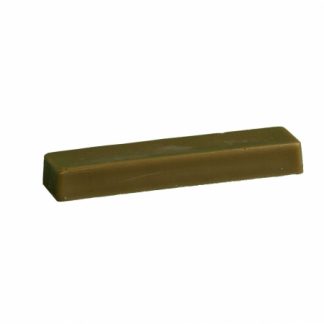 This is a solid block of carnauba wax, popular with woodturners. It gives a bright gloss finish and is also very hard wearing, able to withstand a medium amount of handling without showing finger marks. Apply over a sanding sealer by holding it against your work at it revolves on the lathe. Do not press too much – the wax is very hard and can scratch softer woods – the idea is to generate enough heat for the wax to melt slightly and transfer onto the wood. (This is easier than it sounds!). Use sparingly, and use the polishing process (using safety cloth) to ensure the wax is spread evenly. Buffing will produce a high gloss finish.
This is a solid block of carnauba wax, popular with woodturners. It gives a bright gloss finish and is also very hard wearing, able to withstand a medium amount of handling without showing finger marks. Apply over a sanding sealer by holding it against your work at it revolves on the lathe. Do not press too much – the wax is very hard and can scratch softer woods – the idea is to generate enough heat for the wax to melt slightly and transfer onto the wood. (This is easier than it sounds!). Use sparingly, and use the polishing process (using safety cloth) to ensure the wax is spread evenly. Buffing will produce a high gloss finish. -
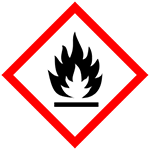
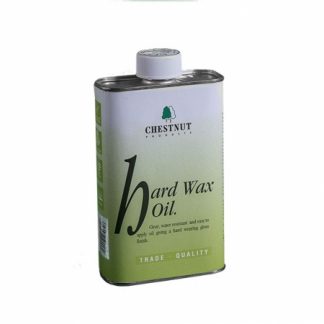
 If you’re looking for a clear finish that is tough, hardwearing and gives a satin lustre yet is still very easy to apply, even on larger areas, you’re in the right place.
Hard Wax Oil is a particular blend of tough oils combined with special waxes which dries to an exceptionally resilient finish. Ideal for anything that is going to be subjected to water splashes or a lot of handling this oil may not be indestructible but it will stand up to a lot of abuse.
It retains the ease of application typical of an oil and it stays wet long enough to get a smooth, even finish – even on large areas – but is touch dry and tack free in about 20 minutes, and better yet is ready for a second coat after about four hours (in normal conditions).
Hard Wax Oil will build to a bright gloss finish after 2-3 coats. Rub down lightly between coats with a fine abrasive. Once hard dry (allow at least 24 hours) it can be brought to an even brighter shine using either the buffing wheel system or burnishing cream.
For a not-quite-so-bright finish use a mild abrasive to reduce the gloss. For best results lubricate the abrasive with microcrystalline wax to retain the toughness of the oil.
If you’re looking for a clear finish that is tough, hardwearing and gives a satin lustre yet is still very easy to apply, even on larger areas, you’re in the right place.
Hard Wax Oil is a particular blend of tough oils combined with special waxes which dries to an exceptionally resilient finish. Ideal for anything that is going to be subjected to water splashes or a lot of handling this oil may not be indestructible but it will stand up to a lot of abuse.
It retains the ease of application typical of an oil and it stays wet long enough to get a smooth, even finish – even on large areas – but is touch dry and tack free in about 20 minutes, and better yet is ready for a second coat after about four hours (in normal conditions).
Hard Wax Oil will build to a bright gloss finish after 2-3 coats. Rub down lightly between coats with a fine abrasive. Once hard dry (allow at least 24 hours) it can be brought to an even brighter shine using either the buffing wheel system or burnishing cream.
For a not-quite-so-bright finish use a mild abrasive to reduce the gloss. For best results lubricate the abrasive with microcrystalline wax to retain the toughness of the oil.

-

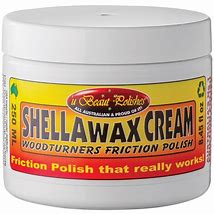 Shellawax cream is a woodturners friction and buffing polish. Sharing many of the characteristics of Shellawax liquid, Shellawax Cream is specially formulated for use on larger turned projects where it would normally be impossible to get a first class finish using a conventional friction polish and on stand-alone articles such as carvings. As with Shellawax, only one application is required to completely finish the work. Made using a specially formulated hard shellac as a base, this excellent product gives a hard, durable finish, with impressive resistance to marks and blemishes from water, alcohol and heat. The cream formulation retards the frictional drying characteristic of friction polishes, making it suitable for use on larger lathe-turned items such as bowls and platters. Being a cream, this product is easily controlled in application and is very economical in use. Shellawax Cream is non-toxic.
Shellawax cream is a woodturners friction and buffing polish. Sharing many of the characteristics of Shellawax liquid, Shellawax Cream is specially formulated for use on larger turned projects where it would normally be impossible to get a first class finish using a conventional friction polish and on stand-alone articles such as carvings. As with Shellawax, only one application is required to completely finish the work. Made using a specially formulated hard shellac as a base, this excellent product gives a hard, durable finish, with impressive resistance to marks and blemishes from water, alcohol and heat. The cream formulation retards the frictional drying characteristic of friction polishes, making it suitable for use on larger lathe-turned items such as bowls and platters. Being a cream, this product is easily controlled in application and is very economical in use. Shellawax Cream is non-toxic.
-
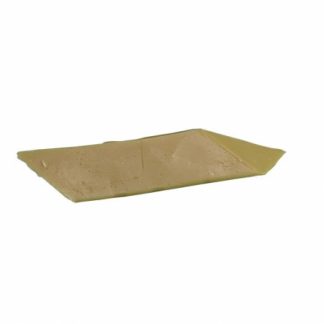 Woodturners stick wax is a mixture of beeswax and carnauba wax it is slightly softer than the Carnauba Wax Stick and therefore slightly easier to apply and there are no concerns about it marking softer woods. Applied over a sanding sealer, simply hold the stick against the revolving work and allow the heat generated to melt the wax onto the wood. Buff up straight away using Safety Cloth, using the cloth to ensure an even coating.
Woodturners stick wax is a mixture of beeswax and carnauba wax it is slightly softer than the Carnauba Wax Stick and therefore slightly easier to apply and there are no concerns about it marking softer woods. Applied over a sanding sealer, simply hold the stick against the revolving work and allow the heat generated to melt the wax onto the wood. Buff up straight away using Safety Cloth, using the cloth to ensure an even coating. -

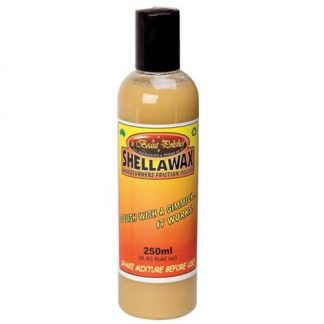 A one-application woodturners friction polish that really does work and is ideal for use on smaller spindle work such as pens and similar objects up to around 10 cm (4") diameter. This exceptional polish is made using a specially formulated hard shellac as a base to give a harder, more durable finish, giving greater resistance to marks and blemishes from water, alcohol and heat. Normally applied directly onto bare timber (though it can be used over most oils too – but test on scrap first) this polish dries almost instantly yet goes on hardening for up to three weeks resulting in a truly durable finish which far exceeds others on the market today. Once fully cured the finish is food-safe and non-toxic.
A one-application woodturners friction polish that really does work and is ideal for use on smaller spindle work such as pens and similar objects up to around 10 cm (4") diameter. This exceptional polish is made using a specially formulated hard shellac as a base to give a harder, more durable finish, giving greater resistance to marks and blemishes from water, alcohol and heat. Normally applied directly onto bare timber (though it can be used over most oils too – but test on scrap first) this polish dries almost instantly yet goes on hardening for up to three weeks resulting in a truly durable finish which far exceeds others on the market today. Once fully cured the finish is food-safe and non-toxic.
-

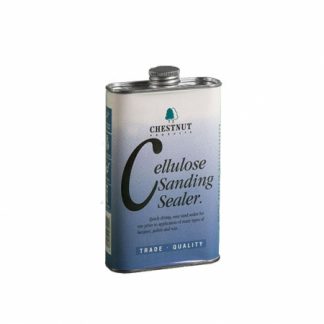
 Good finishing requires a good foundation, and Cellulose Sanding Sealer is probably the best way of providing one. Compatible with everything in the Chestnut Products range that benefits from the use of a sanding sealer (which is pretty much everything apart from oil finishes!) it is superbly universal.
The purpose of a sanding sealer is manifold.
Good finishing requires a good foundation, and Cellulose Sanding Sealer is probably the best way of providing one. Compatible with everything in the Chestnut Products range that benefits from the use of a sanding sealer (which is pretty much everything apart from oil finishes!) it is superbly universal.
The purpose of a sanding sealer is manifold.
- It seals the open pores of the timber prior to the application of the next coat, meaning that more of it stays on the surface and less of the finish is needed. Not only does this make it economical, when finishing the thinner the applied coat the less likely it is to get damaged, so a sanding sealer will help the top coats be more resilient.
- Sanding Sealers also bind the loose fibres of the timber together giving a more solid foundation for the next coat, which helps make sure the final finish is able to adhere properly and thus be more durable.
- They also include a sanding agent which acts as a lubricant to make the sanding process easier – the sanding agent also stands slightly proud of the surface of the sealer and it is this that is denibbed – the sealer itself should still be intact after sanding.

-

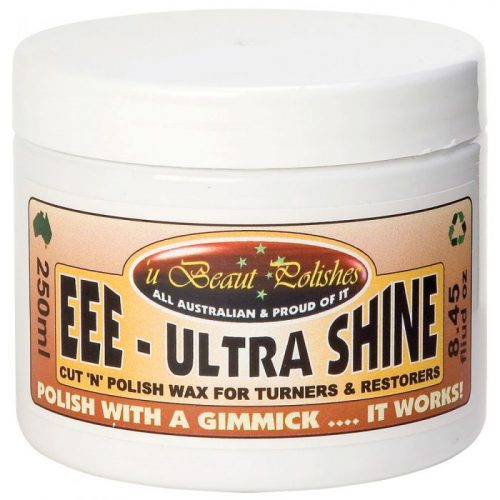 This amazing product is a cut and polish paste containing Tripoli powder, an ultra-fine abrasive. The polish is designed to be used in conjunction with Shellawax Cream and liquid formulations or as a finish in its own right on plastics (such as acrylic, resin-impregnated burr, crushed velvet, artificial ivory and similar products used for pen bodies). It can also be used after French polishing and restorers will find it useful to cut and revive previously polished surfaces. Although designed to be used directly on raw timber, bear in mind that EEE is not a finish in itself and the polished surface will need protecting by the use of some other product (such as Shellawax). EEE-Ultra Shine can be used over many other finishes such as oils and most types of varnish, enhancing the surface and giving it a smoothness and lustre with an ease that you would never have thought possible.
This amazing product is a cut and polish paste containing Tripoli powder, an ultra-fine abrasive. The polish is designed to be used in conjunction with Shellawax Cream and liquid formulations or as a finish in its own right on plastics (such as acrylic, resin-impregnated burr, crushed velvet, artificial ivory and similar products used for pen bodies). It can also be used after French polishing and restorers will find it useful to cut and revive previously polished surfaces. Although designed to be used directly on raw timber, bear in mind that EEE is not a finish in itself and the polished surface will need protecting by the use of some other product (such as Shellawax). EEE-Ultra Shine can be used over many other finishes such as oils and most types of varnish, enhancing the surface and giving it a smoothness and lustre with an ease that you would never have thought possible.

